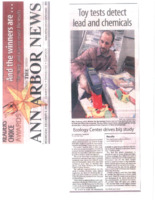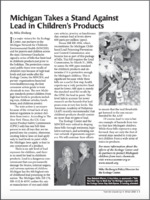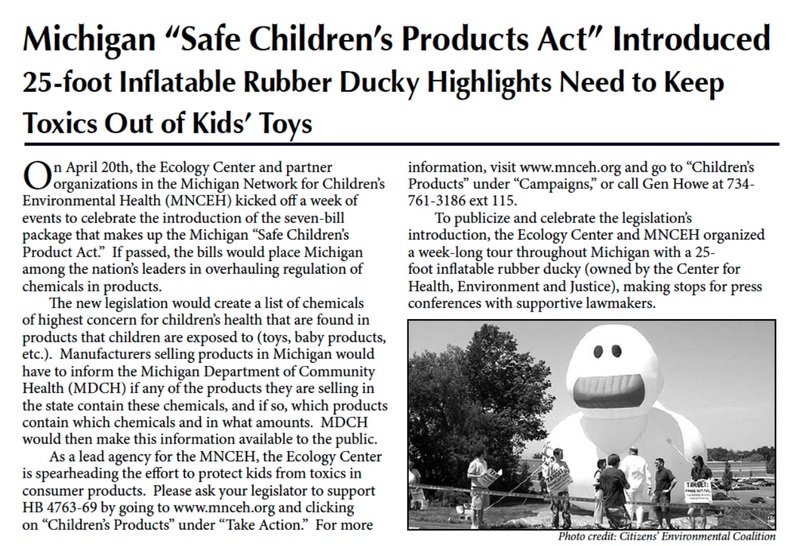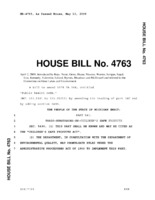Healthy Toys
Initial Report and Testing
In June of 2001 the Ecology Center partnered with GreenPeace to release a report revealing how children were being exposed to hazardous and inadequately tested chemicals through plastic in children’s toys and furniture. These toxins included phthalates, organotins, lead, cadmium, and bisphenol A. Exposing children to these toxic chemicals can cause serious harm to kidneys and lungs, developmental defects, damage to the nervous system, hearing and speech problems, and many other health issues.
Six years later in June 2006, the Michigan House of Representatives passed three bills addressing lead levels in toys. Lead exposure in children can lead to nervous system damage, developmental issues, behavioral disorders, decreased muscle and bone growth, and impaired cell growth. The Ecology Center and the Michigan Network for Children’s Environmental Health began independent testing of children’s toys using an X-ray fluorescence analyzer, which tests for toxic chemical concentrations of lead, mercury, bromines, PVC, and others.In their testing about one in ten toys had at least one chemical of concern.
As part of its advocacy work, the Ecology Center and the Michigan Network for Children’s Environmental Health, sponsored by State Representative Rebekah Warren, brought the results of this testing to the Michigan House of Representatives and to appeal firsthand about the dangers of toxins in toys.
That fall, The Ecology Center announced a new initiative to document testing, product reviews, and health scores, healthytoys.org. The EC tested different children’s products and published the results of such testing on the website, hoping to reduce the increasing incidences of asthma, childhood cancer, and developmental and learning disabilities linked to exposure to these toxic chemicals.
State Policy Advocacy Work
In January 2008, a new package of state laws announced that any toy manufacturers who produced children’s toys with presence of lead over 600ppm would be fined $50,000. The ppm of a substance is a measurement of the number of units of one substance per million units of another. For some context, 35ppm of carbon monoxide is considered toxic. The Ecology Center wondered whether this law provided adequate protection, arguing that lead in any concentration was extremely dangerous. Shortly after, Governor Granholm signed this series of bills into law (SB 174, HB 4132, HB 4399, and HB 4936) expanding limitations on lead in children’s products. This legislation also called on the MDEQ to re-evaluate their standard of products containing less than 600ppm of lead, as the American Academy of Pediatrics recommended no more than 40ppm to be found in children’s items.
The Ecology Centered continued to educate people about the importance of testing and identifying toxic chemical concentrations in children’s toys. In 2009, it hosted two “Toy Testing Town Hall'' events in Detroit and Brighton. These events allowed people to ask questions and learn about the dangers of exposure to toxic chemicals present in many toys, as well as bring their toys to be tested.
Into the spring of 2009, The Ecology Center and The Michigan Network of Children’s Environmental Health toured across the state to celebrate the introduction of the Safe Children’s Product Act. The organizations were accompanied on this tour by a 25 ft inflatable duck to highlight toys that may contain toxic chemicals, like a rubber duck, and to bring awareness to the act. On May 13, 2009, the Michigan House passed the Children’s Products Safety Act (HB 4763-69), The Ecology Centered celebrated as this was, “A first step toward protecting children from toxic chemicals in children’s products.” This act, comprised of contained 7 bills, that created a list of chemicals of highest concern for children’s health and products that might have levels of concentration leading to exposure, working with the Department of Community Health (DCH) and the Department of Environmental Quality (DEQ) to issue administrative rules., It also would required manufacturers to inform the Michigan Department of Community Health (MDCH) if any of their products have dangerous chemicals and what concentrations they are found in for these products to be sold in the state of Michigan, information thatand MDCH would make all of this information accessible to the public.
The passage of the Safe Children’s Product Act would become the nation's first “Right to Know” policy regarding toxins in toys in the country., The act would also help responsible toy businesses in Michigan, as they have the infrastructure to continue to sell their products that followed these guidelines, and would encourage Michigan-manufactured products who would adhere to the new policy. The bill would create a list of chemicals of highest concern for children’s health and are present in common products. However, this bill was not perfect, as it did not outright ban or restrict the use of these chemicals in products. Furthermore,and small toy manufacturers, retailers, and industrial users were all exempt from the legislation.
Although the passage of the Children’s Products Safety Act was a major win for protecting children from toxic chemical exposure, the fight against creating safe children’s products and toys was not over. In the same month as HB 4763-69’s passing, the Ecology Center urged its readers to write to five major toy manufacturers asking them to label harmful chemicals in their products, and to model their accessibility of information on toxic chemicals present in products after the European REACH law, requiring manufacturers to list “Candidate List of substances of very high concern” on products.
The Ecology Center strived to involve their members in advocacy and education. They encouraged members to host their own “Home-Safe-Home” parties, where they could test children and everyday products and spread awareness to their friends and families. They also provided newsletter readers with contact information for local representatives and sample scripts in order to push for increased regulations for toxic chemicals in children and pet products.
In September 2009, the Ecology Center launched HealthyStuff.org website. This website housed a database with information on toxic chemical concentrations in over 900 common household products including pet toys, cars, children’s car seats, back-to-school products, purses, and so much more. Armed with the knowledge of what was in everyday products, this initiative helped give people agency over what products they purchased. This website expandedHealthyToys.org and HealthyCars.org to include more daily products. It was the largest independent database of toxic chemicals in consumer goods at the time of its launch.
Jeff Gearhart, EC Research Director and creator of the site: “The more we test, the more we find that the presence of toxic chemicals is widespread in everyday consumer products. It should not be the responsibility of public health advocates to test these products. Product manufacturers and legislators must take the lead and replace dangerous substances with safe alternatives.”
Throughout the fall, The Ecology Center continued to host testing events to raise awareness for the need for safer household products. They hosted a Halloween toy and costume testing event and continued toy testing events throughout the state. They also started a petition to urge congress to update the Toxic Substances Control Act to increase regulations on toxic substances.






